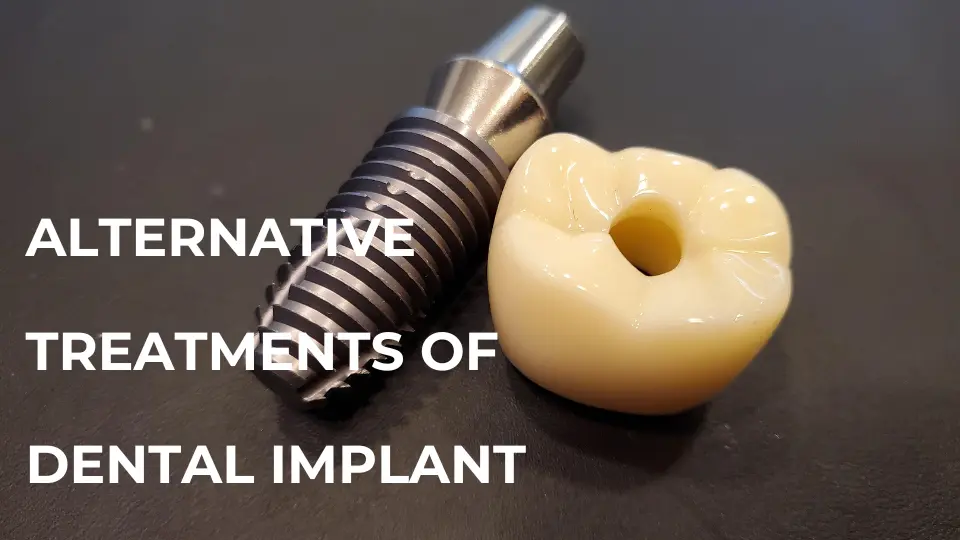
Dental implants are the most effective way to replace lost teeth, but they are not the best option for every patient. Implants may not be appropriate for elderly patients due to factors such as inadequate jawbones, a lengthy treatment process, high costs, or the unsuitability of elderly patients for surgical procedures. For example, if the bone volume is insufficient, additional surgical procedures such as bone grafting may be required first, which may complicate the treatment and increase the cost.
In addition, some systemic health problems (uncontrolled diabetes, immune problems, bisphosphonate use, etc.) or heavy smoking may adversely affect implant success. In such cases, patients may turn to alternative treatment methods other than implants to eliminate tooth deficiencies.
In this article, we will discuss the main alternative treatments that can be applied in cases where implants cannot be performed or are not preferred, in the light of an expert opinion. We will examine in detail the advantages, disadvantages, application process, lifetime, cost, comfort and aesthetic effects of each method. Thus, we aim to help people with missing teeth to determine the most suitable solution for their situation.
Conventional Fixed Bridges (Traditional Dental Bridges)
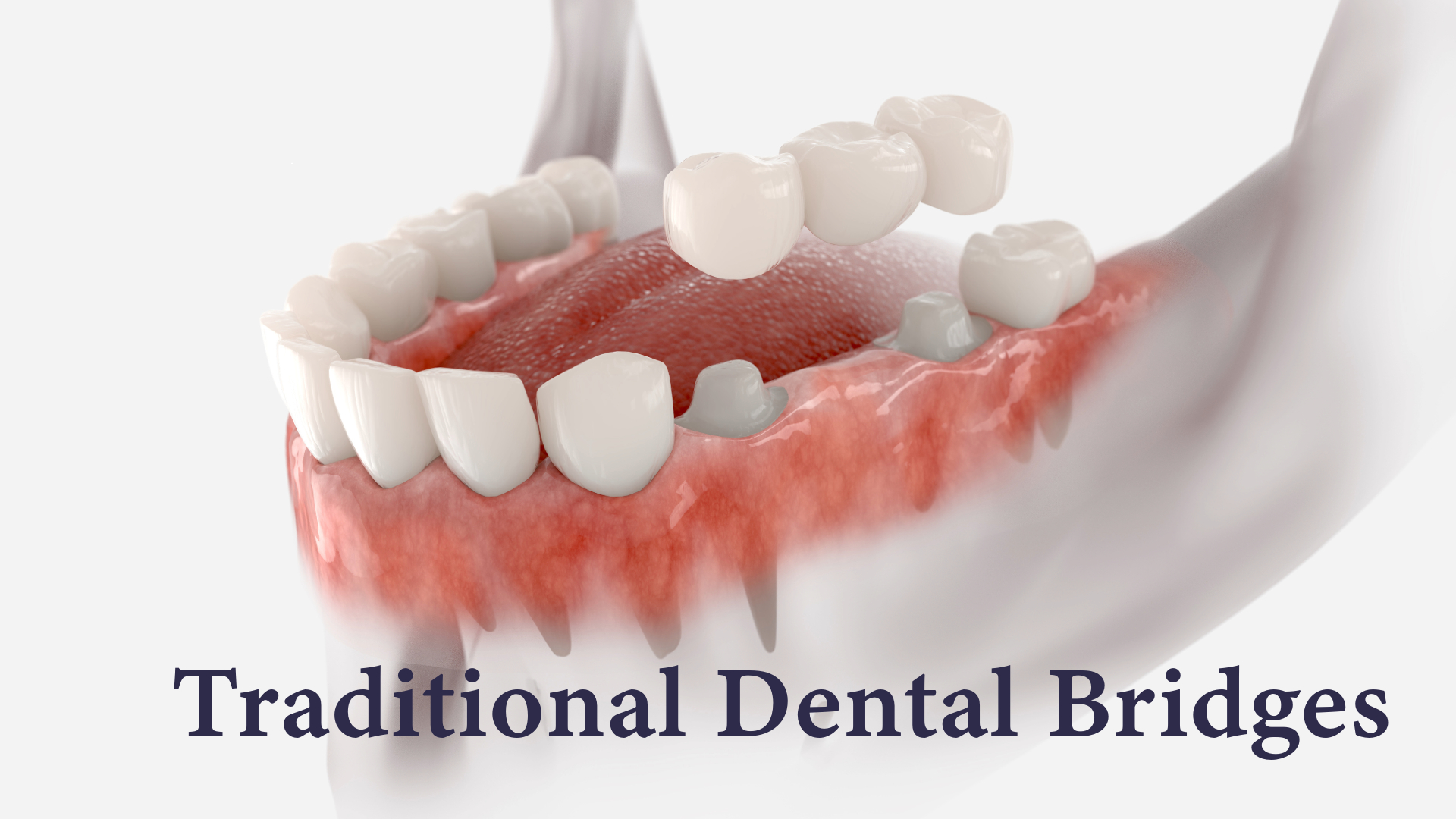
Conventional fixed bridge is a treatment in which the natural teeth on both sides of the gap are cut to fill the gap of the missing tooth(s), veneers (crowns) are placed on them and the artificial tooth is fixed in the gap between them. In other words, the neighbouring teeth are used as support teeth; permanent crowns are made on these teeth and the missing tooth gap is closed with a "bridge".
Advantages
- Fixed and Fast Solution: Since it is permanently fixed in the mouth, there is no problem of wearing and removing it, it offers continuous use like natural teeth. It can usually be completed within a few weeks, compared to implant treatment, the result can be achieved in a shorter time.
- High Chewing Function: When done correctly, it greatly restores the function of the missing tooth. It tolerates chewing forces well and provides the patient with a function close to the missing tooth.
- Aesthetic Restoration: When made with porcelain or zirconium materials, a natural-looking aesthetic that is compatible with the neighbouring teeth is obtained. When viewed from the outside, the bridge tooth is usually indistinguishable.
Disadvantages:
- Cutting of Neighbouring Teeth: The biggest disadvantage is that intact neighbouring teeth have to be reduced in size. The enamel and dentin tissue of the neighbouring teeth that will support the bridge is eroded. This is an irreversible loss of material and increases the risk of sensitivity or the need for root canal treatment in the future.
- Difficult Cleaning: The space under the bridge (under the fixed artificial tooth) cannot be cleaned with normal brushing. For oral hygiene, special super floss floss or interface brushes should be used. If not cleaned well, caries or gum problems may develop in the supporting teeth.
- Weakening of the Bridge Support: Since the bridge places a load on both teeth, there is a risk of porcelain veneer leakage, caries development or fracture of the tooth in the mouth, especially in the support teeth over many years. If one of the support teeth develops a problem, the entire bridge may need to be replaced.
- Limited Scope of Application: It is not always possible to build bridges in very long edentulous gaps (when many teeth are missing in a row), because carrying an excessively long bridge with a small number of teeth is biomechanically prone to failure. In such cases, different solutions are considered.
Maryland Bridges (Resin-Bonded Bridges)
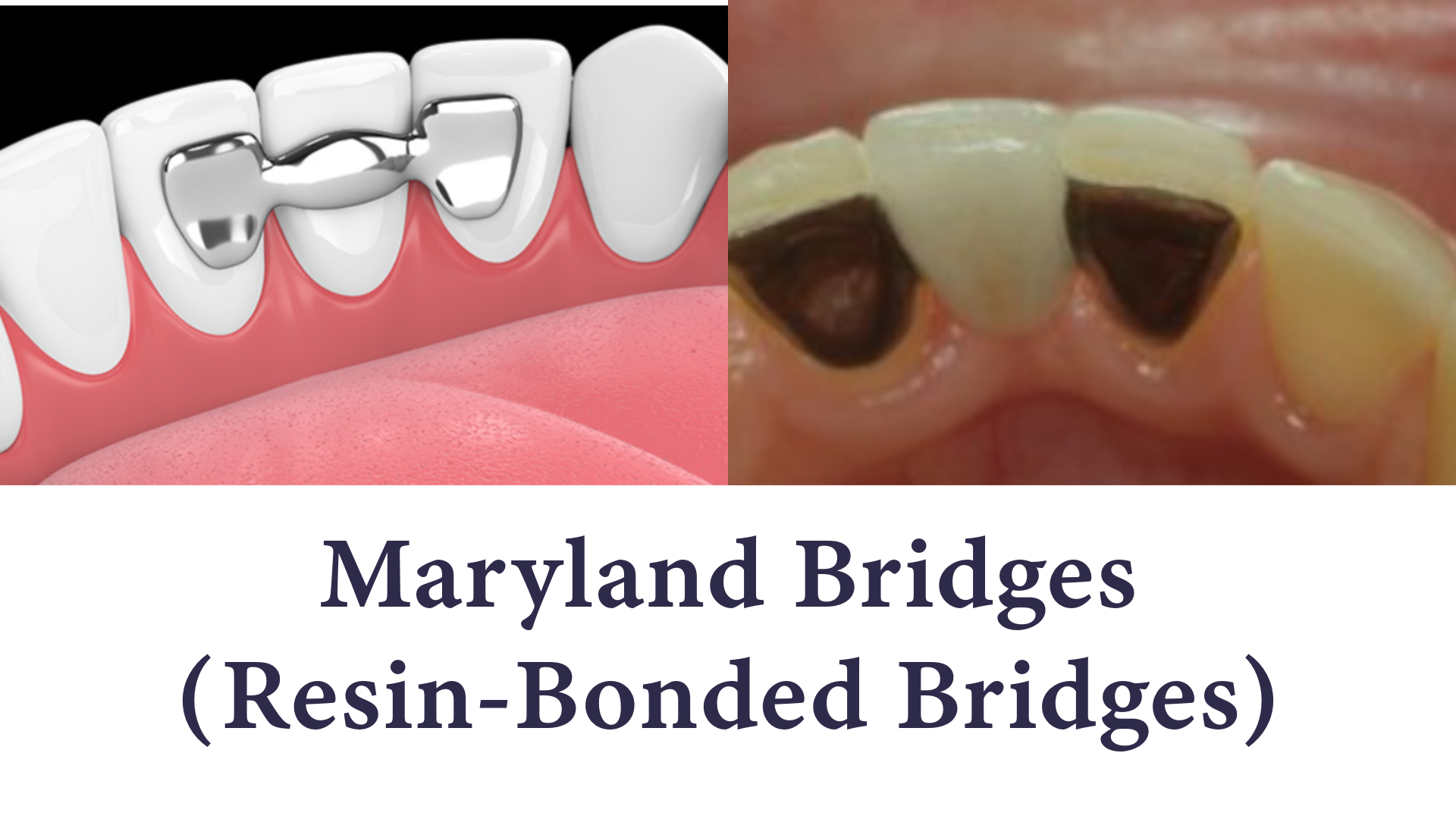
Maryland bridges (resin bonded bridges) are fixed prostheses that are applied by bonding metal or ceramic fins to the posterior surface of the teeth next to the missing tooth, instead of crowns that completely cover the neighbouring teeth. In this method, the artificial tooth (pontic) that fills the missing tooth cavity is attached to the adjacent teeth with thin extensions. The appearance of the Maryland bridge resembles a flying bat with an artificial tooth in the centre and "wing" shaped extensions on both sides; the wings are attached to the tongue-facing surface of the support teeth with a strong adhesive using resin cement. In this way, the missing tooth is completed with minimal abrasion of the neighbouring teeth.
Advantages:
- Minimally Invasive (Tooth Friendly): The Maryland bridge requires much less tooth cutting than a traditional bridge. It is only necessary to make small roughenings or shallow cavities on the back surfaces of the neighbouring teeth; the entire teeth are not reduced in size. Thus, intact tooth tissue is preserved to a great extent. It offers a minimally invasive solution, especially in young patients, as large preparations are not made before the teeth have completed their full development.
- No Surgery Required and Painless: Since there is no implant or surgical procedure in this method, even anaesthesia is usually not needed during the procedure. Only the bonding process is applied. Therefore, it is a good alternative for people with health problems that prevent surgery (e.g. bleeding disorders, serious heart conditions) or patients who do not want surgery.
- Fast and Practical: Maryland bridge can be completed in one or two sessions. Most of the time, after measurements are taken and the metal/ceramic winged pontic is prepared in the laboratory, bonding is performed at the second appointment. In some cases, the physician can even apply it directly in the clinic with ready-made fibre-reinforced composite materials. The short duration of the treatment and the fact that it does not require a recovery period saves time for the patient.
- Aesthetic Applicability: Especially in the anterior tooth area, when made with the right materials, highly aesthetic results are obtained. Since Maryland bridges made of zirconium ceramic do not have a metal substructure, there is no problem of discolouration of the supporting teeth. Today, thanks to the full ceramic winged Maryland bridges, the grey shade problem that used to occur due to metal reflection has been minimised. A close transparency and colour matching to natural teeth can be achieved.
Disadvantages:
- Risk of Dropping/De-bonding: The retention of Maryland bridges depends on the adhesive resin and wing design. Especially in the posterior region, when exposed to strong chewing pressure or in case of trauma, the wings may separate from the tooth (de-bonding). The reason for lower success rates in the past was the limited availability of adhesive technology; today, even though bonding methods have improved, the risk of falling off is slightly higher than with full crowned bridges. Therefore, caution should be exercised in posterior tooth spaces with excessive force or in patients with teeth clenching habits.
- Limited Indication: Generally, it is ideal in cases where a single tooth is missing and the neighbouring teeth are intact. In cases where more than one tooth is missing or there is no tooth on one side of the gap (extreme cases), a Maryland bridge cannot be used. For example, Maryland cannot be used in cases where the posterior molars are missing because there is a tooth on only one side of the gap (no support at the back); instead, a cantilever (one-sided) bridge or different prosthesis is considered.
- Aesthetic Limitations (Metal Wing Problem): If the wings of the Maryland bridge are made of a metal alloy, when these wings are bonded to the back of the support tooth, they may produce a slight greyish reflection on the front surface of the tooth. This discolouration can affect the aesthetics, especially on the front teeth. All-ceramic (e.g. zirconium) wings have been developed to solve this problem; however, since all-ceramic wings are not as thin and strong as metal, they may not be suitable for every case. Nevertheless, this disadvantage has been largely overcome with aesthetic materials today.
- Long Term Durability: Statistically, it is stated that it is not as long-lasting as classical bridges. It has been reported that they can be used for an average of 5-10 years without any problems, and after 10 years, re-bonding or renewal may be required. In good cases, however, very good results have been achieved - one study reported a success rate of 95.1 per cent for resin-retained bridges, and that they can be used for 12 to 21 years in the anterior tooth area. Nevertheless, this is the upper limit under ideal conditions; in general, the patient is advised to check the condition of the adhesive at regular intervals.
Cantilever Bridges (Cantilever Bridges)

Cantilever bridge is a special type of bridge made by taking support from the tooth on only one side of the missing tooth gap. In other words, the artificial tooth has a natural support tooth on one side, while the other side remains free (unsupported). Similar to the cantilever (a beam that is fixed at one end and the other end remains in the air) in architecture, imagine a bridge that is glued on one side and "flies" free on the other. For example, if you have lost your rearmost molar, the tooth in front of it can be supported alone to make an artificial tooth (cantilever bridge) that extends towards the back. Or a missing tooth in the anterior region can be completed with the support of only one adjacent tooth.
Advantages
- Solution with Single Tooth Cutting: Since only the tooth on one side of the cavity is prepared in a cantilever bridge, there is no need to cut both teeth as in a conventional bridge. This allows for a more conservative approach; no more teeth are unnecessarily worn down. For example, if your front tooth is missing and there is no need for a large filling or crown on one of the neighbouring teeth, it is possible to complete the missing tooth by only crown one neighbouring tooth.
- Suitability in the Aesthetic Area: This type of bridges can give both a functional and attractive result, especially when used to close small tooth gaps in the aesthetic area of the front teeth. For example, in a person who has no congenital lateral incisor, smile aesthetics can be achieved by preparing a canine tooth and placing a cantilever tooth in the lateral tooth gap. When planned correctly, it is not distinguished from other teeth in appearance.
- Less Likelihood of Complications: Some experts state that the likelihood of complications is reduced when working on a single tooth and making a more "simple" prosthesis. This is because a restoration that involves fewer teeth, even if a problem arises, occurs in a more limited area and can be easier to repair. In addition, since the cantilever bridge is not a complex procedure like implant surgery, there is no risk of surgical complications.
- Being Reversible When Necessary: With a cantilever bridge, only one tooth is covered. In the future, it is relatively easy to remove the cantilever bridge and switch to a different treatment if the patient wishes or if circumstances change (e.g. if it is possible to implant an implant on the other side of the gap). So the treatment can be considered reversible; at least you do not sacrifice the other neighbouring tooth, so your options remain open.
Disadvantages:
- Unilateral Load and Risk of Damage: In a cantilever bridge, the entire chewing load on the artificial tooth is transmitted to a single support tooth. This asymmetrical load distribution leads to stress at the connection of the support tooth and the bridge. As a result, cantilever bridges have a higher risk of fracture or loosening of the adhesive. When encountering large forces, especially in the posterior tooth region, the free end of the bridge may try to move up and down, loosening the crown on the supporting tooth or causing porcelain fractures.
- Additional Stress on the Support Tooth: Since the single support tooth will carry more force than normal, the roots and periodontal tissue of this tooth must be resistant to this load. If the support tooth is previously root canal treated (devitalised), the probability of failure increases due to increased fragility. In a study, it was reported that failures of cantilever bridges were more frequent when non-vital (root canal treated) teeth were used as abutments. So ideally, the support tooth should be a healthy and strong tooth.
- Risk of Aesthetic Incompatibility: When a cantilever bridge is used in the anterior region, such as a lateral tooth supported by a canine, there may be slight differences in the symmetrical appearance when the supporting tooth changes position. The alignment of the teeth may not be natural or aesthetic restorations may be required to cover the shape differences. This is also a matter of orthodontic planning (in some cases, the missing tooth gap is closed orthodontically and the canine is shaped like a lateral canine). A similar aesthetic adjustment may be needed when a cantilever bridge is constructed.
Removable Partial Dentures (Partial Dentures)

Removable partial dentures are removable prostheses made for patients with some teeth present in the mouth and some missing. The missing teeth are replaced by artificial teeth and the prosthesis usually has an acrylic body and a metal framework. They are fixed in the mouth with hooks (clasps) or precision retainers that attach to the remaining natural teeth, but can be removed by the patient for cleaning. These prostheses are also colloquially referred to as "half palates" or simply "dentures". For example, if you have lost your back teeth in the lower jaw but retain your front teeth, a removable prosthesis can be made that attaches to the front teeth and contains artificial teeth to replace the back teeth.
Advantages:
- Completes Multiple Teeth at the Same Time: Partial dentures are an effective solution for common tooth deficiencies. When multiple teeth are missing in a mouth, it may not be possible to complete all of them with a bridge; in this case, the gaps in different areas can be filled together with a single removable prosthesis. For example, for someone who is missing both right and left back teeth, a single U-shaped prosthesis can be made instead of two separate bridges and all gaps can be filled.
- No tooth cutting required: Unlike fixed bridges, removable dentures usually do not require the cutting of intact teeth (only in some cases small cavities or metal supports may be added to the teeth to be used as retainers, but not as much as a crown). This means that you can fill in the gaps with almost no damage to your existing natural teeth. The prosthesis is usually attached to the teeth with wire hooks called crochets; these hooks fit into the neck area of the teeth and wrap around the tooth.
- Fast Application Process: The prosthesis can be prepared in a few sessions. Since it does not require surgical procedure, the healing period is not expected; after the measurements are taken and rehearsals are made, the prosthesis is delivered in a short time. It is usually completed in a total of 4-5 appointments and the whole process is completed within a few weeks. In emergencies (e.g. if teeth are required immediately after extraction of the front teeth), temporary prostheses can be made even faster.
- Easy adaptability: Partial dentures can be partially adapted to changes in the oral condition in the future. For example, if you lose another tooth some time after the prosthesis is fitted, a new artificial tooth can be added to the existing prosthesis and its use can continue. In the same way, the fit can be improved by making liners called "feeding" under the prosthesis. This modification possibility is an advantage of removable prostheses compared to fixed prostheses.
- Lip and Cheek Support: Cheeks may collapse inwards, especially in large tooth deficiencies. Partial dentures also partially correct facial aesthetics by supporting the lips and cheeks thanks to their acrylic bases. It recovers the collapsed appearance caused by tooth loss and improves the profile appearance.
Disadvantages:
- Removable (Acclimatisation Process): Perhaps the biggest disadvantage of the removable prosthesis is that it creates a foreign body sensation in the patient's mouth and the patient has to put it in and out every day. At first use, there is a feeling of unfamiliarity; the patient may feel as if his mouth is full and this may take some time to get used to. Especially in the beginning, the prosthesis may move while eating or talking and may cause insecurity. It is also possible to have difficulty pronouncing some words during this period. However, most users get used to the prosthesis in about 2-4 weeks.
- Lack of Stability: Partial dentures are not as stable as fixed dentures. They may move slightly when speaking or chewing. Especially lower jaw prostheses are more mobile due to tongue and lip movements. This movement may cause the prosthesis to knock (press on the oral tissues and cause a wound). For the first few weeks, the dentist will make adjustments to remove these bumps; however, the fact that it cannot be completely fixed does not change. Some patients cannot tolerate even this micron-level movement of the prosthesis and may be uncomfortable.
- Comfort Issues: Wearing a large appliance in the mouth is difficult for comfort. If the prosthesis has an acrylic plate covering the palate, there may be a decrease in taste and temperature sensation. Although dentures with metal frameworks are thinner, they still require some getting used to by the tongue and cheeks. There may also be some initial pain in the teeth where the hooks touch; this will disappear over time. Nevertheless, chewing comfort is significantly lower than with natural teeth. The user must take into account that the prosthesis may move when biting hard foods.
- Aesthetic Restrictions: Metal hooks used in partial dentures can sometimes be seen while smiling and may adversely affect aesthetics. Especially the metal hooks attached to the anterior teeth can be noticed during speaking or smiling. This is cosmetically unpleasant for some patients. Alternatively, this appearance can be reduced with tooth-coloured plastic crochets or hidden retainers called sensitive retainers, but this is not feasible in all cases or requires extra costs. In other words, the aesthetics of removable dentures may not be as perfect as fixed dentures.
- Pressure on Teeth and Tissue: Dentures transmit force to the palate and gums during chewing. This can cause melting of the gum tissue with pressure, as it does not receive support from the bone like the natural tooth root. In addition, the teeth to which the hooks are attached also take force, and in the long term, wear or gingival recession may occur in those teeth. In other words, while filling a part of the prosthesis, it may put extra load on the teeth on which it rests and if careful cleaning is not done, it may prepare the ground for decay of those teeth.
- Need for Regular Maintenance and Renewal: Removable prostheses lose their fit over time; as the underlying bone melts, the prosthesis becomes loose and does not fit properly. Generally, this harmony should be corrected by relining every 2-3 years. In addition, after 5-7 years, wear, discolouration and aging of the general structure of the prosthesis teeth may occur and a completely new prosthesis may be required. The patient should be under the lifelong follow-up of the dentist. It requires discipline to remove and clean the denture every day and to provide tissue rest by removing it at night if possible. Otherwise, fungal infections (prosthesis stomatitis) and bad odour may occur under the prostheses that are not kept clean. This care routine may be difficult for some patients.
Flexible (Thermoplastic) Partial Dentures
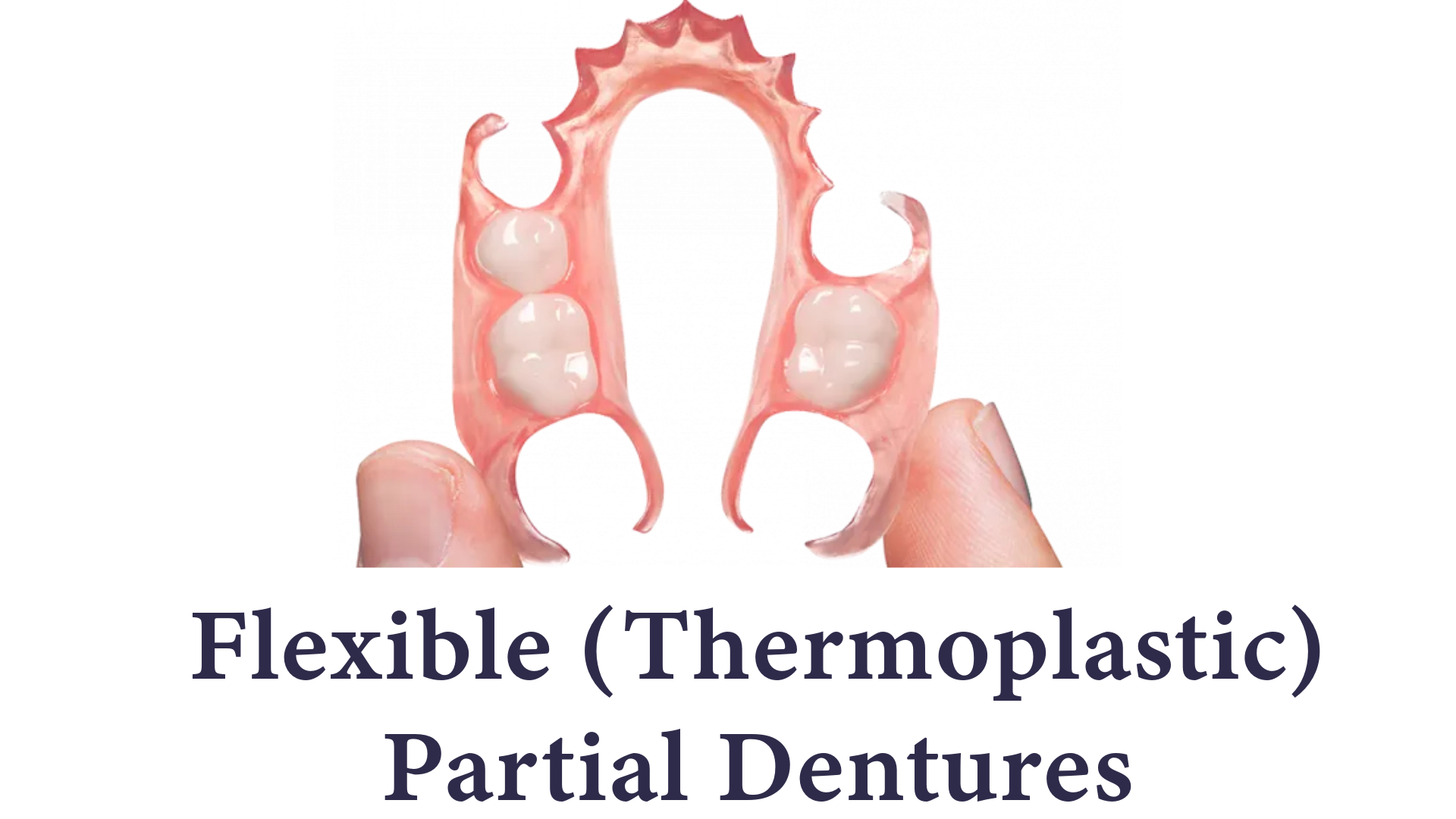
Flexible partial dentures are removable prostheses made of thermo-plastic (nylon) material, developed as an alternative to classical metal-bodied prostheses. The best known brand is Valplast. The main difference of these prostheses is that a thin and bendable pink resin material is used instead of a metal skeleton. The gum-fitting parts are translucent pink in colour and blend in with the patient's own gums. Flexible clasps made of the same pink resin are usually used to attach to the natural teeth - these clasps are almost imperceptible because they are gum-coloured. Flexible dentures are a popular option in some cases of tooth loss, especially in patients with metal allergies or who are uncomfortable with the appearance of metal clasps.
Advantages:
- Shatter Resistant and Safe: The flexible denture material is a high-strength nylon polymer. Even if it falls to the floor, it does not crack or break easily like conventional acrylic dentures. This is an important advantage for patients who frequently drop their dentures or want to feel more secure. In addition, since it is not metal, it does not create any sharp edges and cause injury to the mouth; it is more forgiving to trauma.
- Thinner and Lighter: They can be designed thinner than metal-supported dentures. They take up less volume in the mouth and have a softer feel. This can reduce the time it takes to get used to speaking and eating, especially with dentures. Patients often find the slightly flexible structure of flexible dentures more comfortable than rigid acrylic.
- Metal Free - No Allergy Problems: Because it is completely metal-free, it is ideal for patients with metal allergies or sensitivity. Some people may experience galvanic current or allergic reactions in the areas where metal prosthesis hooks touch; these risks are eliminated with flexible prostheses. In addition, since there is no metal, there are no funny situations such as beeping in airport security devices (a small detail but an interesting comfort for some patients).
- Aesthetic Clasps: Perhaps the biggest advantage of these prostheses is that they have invisible clasps. The handles that attach to the teeth are made of acrylic in pink or transparent colour and integrate with the patient's gums. Thus, even in the front tooth area, it is not noticed that there is a prosthesis hook. The problem of metal glare when smiling is eliminated and the patient feels more confident.
- Softer and More Comfortable: Because flexible denture material has a light rubber-like texture, it is softer against the gums. While rigid acrylic dentures can irritate the tissue from time to time, flexible dentures offer a surface that is compatible with soft tissue. This means that there is less chance of dents and pain when worn for a long period of time. Many users report that the flexible prosthesis feels almost non-existent and that they can chew more easily.
- Extra retention and adhesive-free use: Due to their flexibility, flexible dentures hold on to the teeth like a latch. This means that in some cases they can hold more firmly than conventional dentures. The manufacturers even emphasise that in most cases there is no need for extra adhesive (denture cream). This can be reassuring for patients who fear that their prosthesis may fall out.
Disadvantages:
- Bacterial Accumulation and Cleanliness: Flexible denture material has a porous structure and its surface may not be as smooth/polishable as hard acrylic. This predisposes to the accumulation of bacterial plaque. If not properly cleaned daily, germs may accumulate on the denture and a bad odour may develop. In addition, the colour of the material may change slightly over time due to the pigment in the mouth or it may stain. For this reason, those who use flexible dentures should take extra care in cleaning (soaking in special denture cleaning solutions, etc.).
- Difficulty of Repair: When a fracture or crack occurs in a traditional acrylic prosthesis, it is usually possible to repair it in the laboratory. However, flexible prostheses are not easily repaired; when they break or tear (which may be rare), it is often necessary to make a new one. Likewise, modifications such as the addition of additional teeth are not as simple as in classical prostheses; the material does not weld, adding new parts can be tedious. Therefore, flexible prosthesis may be risky in patients who may experience tooth loss in the future.
- Stability problem if there is little support: Flexible prostheses work best when there are several strategic teeth in the mouth and the prosthesis can hold firmly to them. If there are too few teeth or if the teeth are short or small, the retention of the flexible clasps may be insufficient. In this case, the prosthesis will move and the patient will be dissatisfied. In other words, it is not suitable for all cases; it may be good especially in cases of near complete dentition (e.g. small prostheses with unilateral free ends), but it may not be as stable as a normal prosthesis in large edentulism.
- Chewing Strength and Flexibility: While the flexibility of the prosthesis provides comfort, it can also be a disadvantage in terms of force transmission. When biting very hard foods, the prosthesis may flex and you may not be able to apply an effective force. As metal frame prostheses are more rigid, they transmit chewing pressure better, whereas flexible prostheses absorb some energy. Although this is not noticed by all patients, it may cause dissatisfaction in those who seek a strong chewing sensation.
Complete Dentures
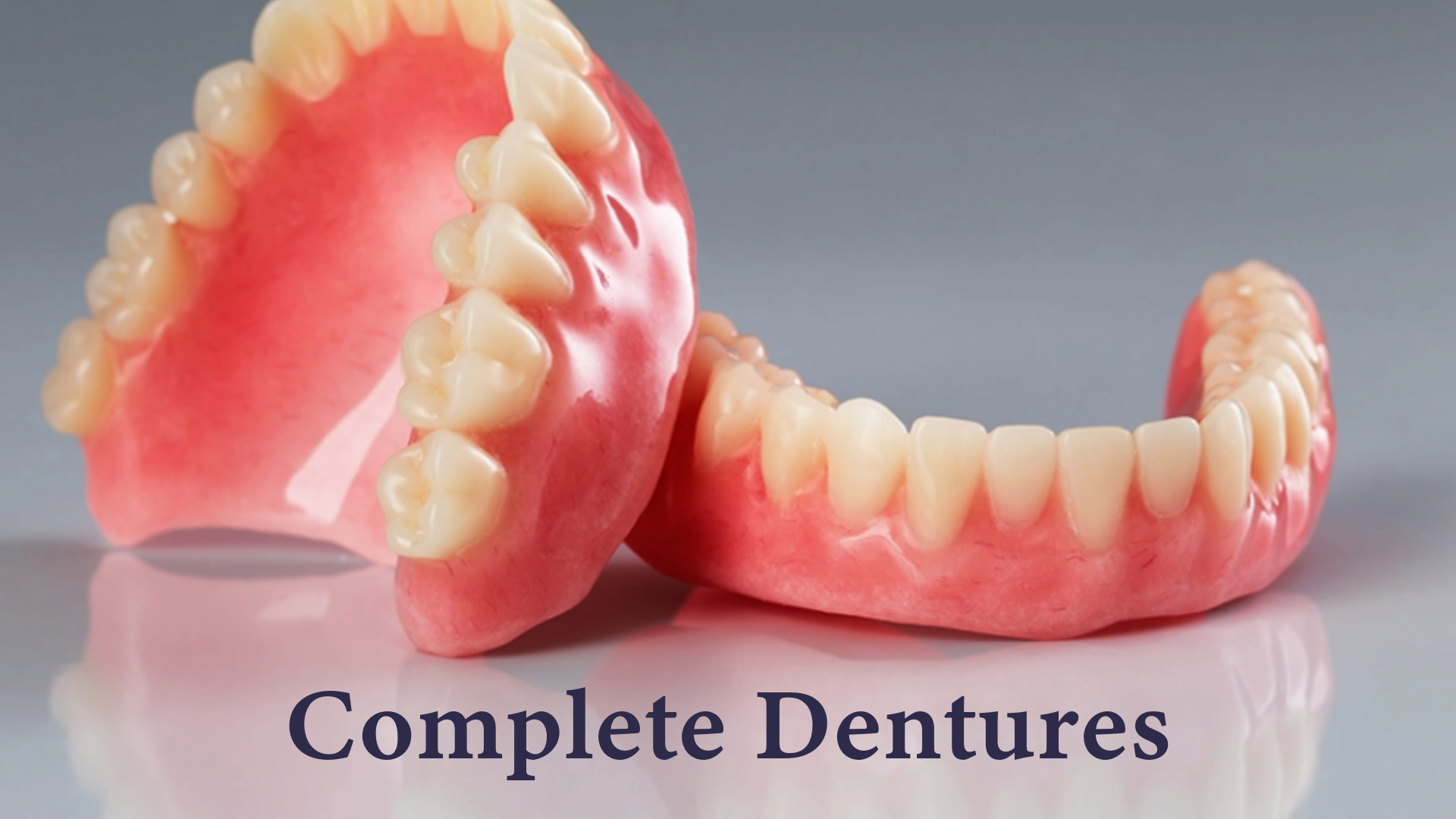
Complete dentures are removable prostheses that fill the entire dental arch (upper or lower jaw) with artificial teeth for patients who have no natural teeth left in their mouth (complete edentulism). They are also known colloquially as "dentures" or simply "palates". An upper jaw complete denture is an appliance that covers the palate extensively, while a lower jaw complete denture has a horseshoe-shaped acrylic body. Acrylic or porcelain teeth containing all the teeth of a complete jaw are arranged on them. The teeth are placed on a pink acrylic base; this pink part mimics the patient's gingiva and sits on the alveolar crest. The dentures are held in the mouth with vacuum effect, muscle support and patient control.
In cases where implants are not possible or undesirable, complete dentures are the main treatment option for complete edentulism. It is one of the oldest and well-established prosthesis methods in dentistry and has become very comfortable with the development of materials and techniques today.
Advantages
- Solution for Toothless Patients: Complete dentures are the only economical and practical solution for someone who has no teeth left in his mouth. No other method (except implants) can restore all teeth. Thanks to these prostheses, the patient comes out of the toothless state and regains 20 teeth (in classical complete prostheses, 14 teeth in each jaw, i.e. there are usually no second cusps, a total of 28 teeth). This is a great functional and aesthetic gain for someone who has no teeth.
- Aesthetic and Functional Gain: Complete dentures, when done correctly, significantly improve the patient's facial aesthetics. Lips and cheeks that collapse with toothlessness are supported with prosthesis, and a fuller and younger appearance is obtained. The form and arrangement of the artificial teeth can be selected according to the patient's old photographs or facial structure to provide a natural smile. In addition, dentures restore the chewing function to some extent. The patient can now chew soft to medium-hard foods. This is of great benefit in terms of nutrition and general health - the patient is able to consume foods that he/she could not eat with dentures.
- Improves Speech: The pronunciation of some sounds is impaired in people without teeth (especially "f, v, s, z"). Complete dentures replace the teeth and help the tongue and lips to find the correct position. Although it takes some practice at first, dentures usually improve speech function. It enables the patient to speak with self-confidence and to utter words correctly.
- No Surgery Required: No surgical or invasive procedure is required for complete prosthesis. Only impressions are taken and prosthesis is made. Therefore, it can be applied regardless of the age and health status of the patient (there is no obstacle for the prosthesis stage after tooth extractions have already been performed). It is safely applied to people who want to avoid surgery such as implants or who carry surgical risks (for example, very old age, serious diseases).
- Fast Preparation: A complete denture is usually prepared in 4-5 appointments after tooth extractions are completed and the mouth has healed (a total of ~4-6 weeks). With the so-called "immediate loading" immediate prosthesis technique, the patient can even be fitted with a pre-prepared prosthesis on the day of tooth extraction, so that he/she is not left toothless - then a new prosthesis is made a few months later. As a result, the patient is able to regain his or her teeth in a short period of time. There is no waiting period for months like an implant (bone healing etc. is not expected).
Disadvantages:
- Stability Problem (Risk of Movement and Dislodgement): The biggest problem of complete dentures, especially in the lower jaw, is that they are difficult to remain stable. This is because there are no natural teeth to hold on to; the dentures adhere to the palate completely by vacuum and adhesion force. Since the upper prosthesis has a large palate area, it usually makes a good vacuum and stops, but the lower prosthesis is easily displaced by tongue and cheek movements. This situation limits the patient's chewing power and confidence. The use of the lower prosthesis is much more difficult than the upper prosthesis.
- Acclimatisation may be difficult: When a complete palatal prosthesis is placed in the mouth of a person with no teeth, it is initially very unfamiliar. Effects such as a full mouth, gag reflex, increased saliva flow and slurred speech are normal in the first few days. The patient may feel overwhelmed. Especially someone who has been toothless for years may have difficulty adapting to the prosthesis. Some patients want to remove the prosthesis in the first weeks and cannot use it. In this period, it is necessary to be patient and follow the recommendations given by the physician.
- Limited chewing capacity: It is difficult to eat very hard, sticky or fibrous foods with complete dentures. For example, it is practically impossible to chew gum with the prosthesis (it sticks and can pull the prosthesis). It may also be impossible to bite hard dried meats and raw vegetables because the lower prosthesis will move. Therefore, patients should change their dietary habits to some extent. It is generally recommended to chew on both sides at the same time so that the prosthesis is balanced.
- Tissue Change and Bone Resorption: The alveolar bones under complete dentures continue to resorb over time because they do not receive tooth root stimulation. Especially in the first 1-2 years following tooth extraction, bone resorption occurs rapidly, then more slowly but lifelong. This means that the support under the prosthesis decreases and the prosthesis loosens. As the bone in the lower jaw melts, it becomes more difficult for the prosthesis to hold on, and even the bone can make sharp protrusions and cause prosthesis strikes.
Root Protected Overdenture Prosthesis
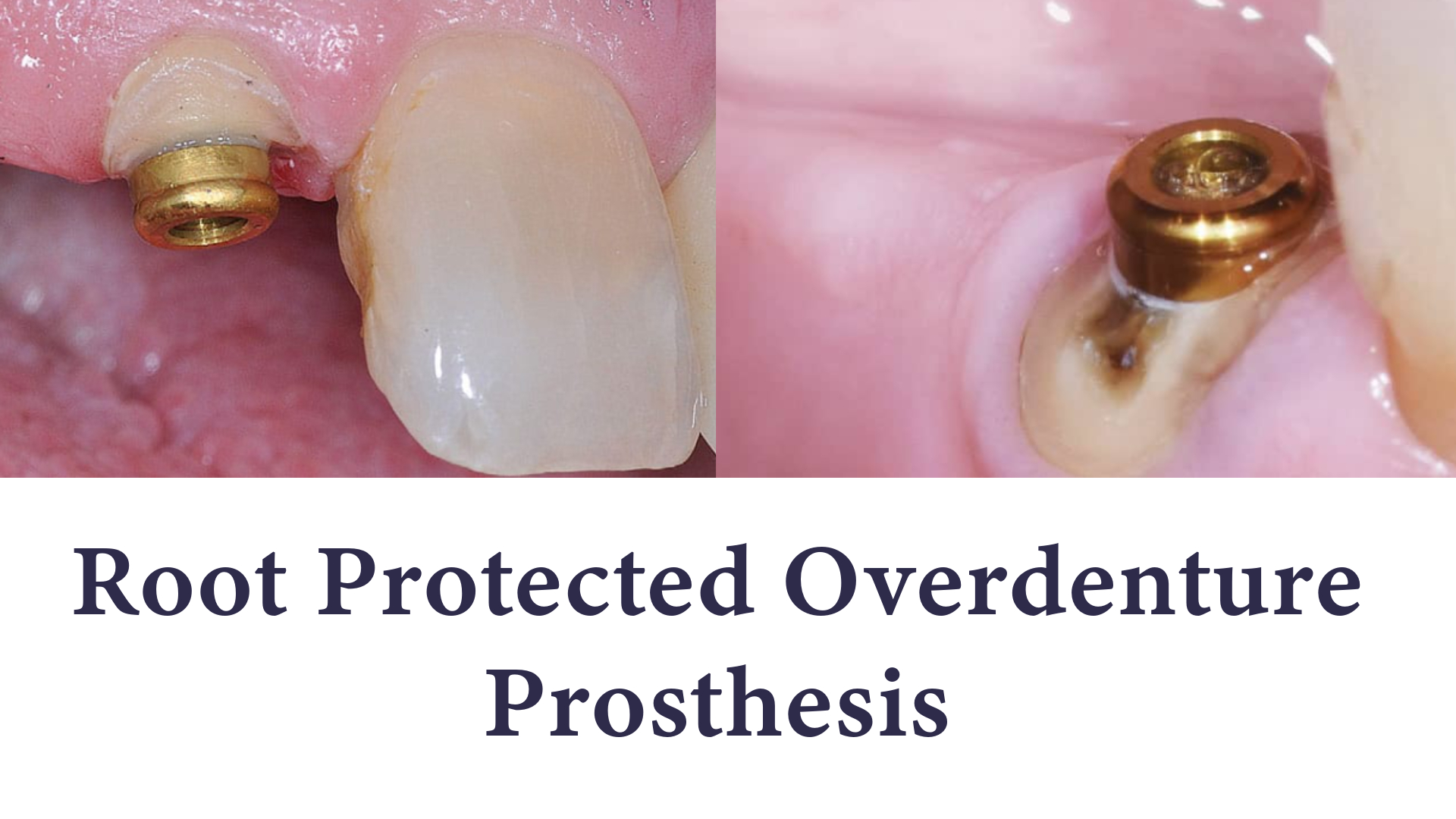
A root-preserved overdenture is a type of complete denture that is supported by several tooth roots that are left in the mouth without extraction. In English, it is known as overdenture. In this approach, the roots of one or more teeth are specifically preserved in the patient's mouth and special caps are made on them so that the complete denture fits over these roots. Thus, the prosthesis receives support from these roots instead of the bare palate as in a completely edentulous mouth. The aim is to increase the retention and stability of the prosthesis and at the same time to reduce jaw bone resorption by the presence of these roots.
This method is usually applied in the lower jaw by leaving the roots of two canines and making a prosthesis over them, because it dramatically improves the retention of the lower complete denture. It can also be used in the upper jaw, where 2-4 roots can be left and these can support the prosthesis. Roots are usually teeth that have lost their vitality, instead of pulling them, canal treatment is performed, the crown part is cut and the root is left.
Advantages:
- Increased Denture Retention and Stability: The biggest advantage of overdentures is that they keep the prosthesis in place, especially in the lower jaw. An overdenture prosthesis made on two solid roots moves much less than a normal lower prosthesis, offering the patient a more secure chewing and speaking experience. Thanks to the special attachments (e.g. knob-link, locator, etc.) placed on these roots, the prosthesis "snaps" into place and does not come out by itself. As a result, the patient is much more comfortable socially; self-confidence increases because the prosthesis will not move. We can say that this advantage is a revolutionary difference for complete lower jaw prosthesis.
- Reduces Bone Resorption: The remaining roots slow down or even stop the resorption of the alveolar crest around them. The natural tooth root is a physiological source of load and stimulation for the bone. As long as it is not extracted, it continues to transmit the pressure to the bone. This means that bone height is better maintained under the prosthesis. Studies show that bone resorption is significantly reduced in overdentures compared to conventional complete dentures. It is said that no implant is as bone-friendly as one's own root; from this point of view, the roots left for the overdenture keep the bone alive.
Disadvantages:
- Need for Maintenance of Remaining Roots: Perhaps the biggest disadvantage of overdenture is that the roots left in the mouth require regular maintenance and control. Even if these roots are root canal treated, they carry the risk of caries. If the area around these roots, especially under the prosthesis, is not cleaned, caries may start on the upper part of the root and the patient may not realise this. To prevent this, special fillings that release fluoride or metal valves (copings) are usually placed on the roots.
- Periodic Problems with Roots: If the remaining roots are from teeth with advanced periodontal (gum) disease, mobility (swaying) may increase over time. Especially roots with weak bone support may be lost in the early period. In this case, the adaptation of the prosthesis is impaired and extra treatments are needed. In addition, in rare cases, root tip infection, cysts, etc. may develop in these roots. At each follow-up appointment, the roots should also be evaluated by X-ray.
- Attachment Cost: If, instead of a simple dome cover, a retaining mechanism (e.g. snap ball attachments or bar attachments) is to be used, these also have a cost. This slightly increases the total cost of the prosthesis. In addition, attachment parts may wear out over the years and may need to be replaced. Especially rubber parts such as o-rings should be renewed periodically. Although these maintenance costs are less than implant maintenance, they can be a burden compared to conventional dentures.
Autogenous tooth transplantation
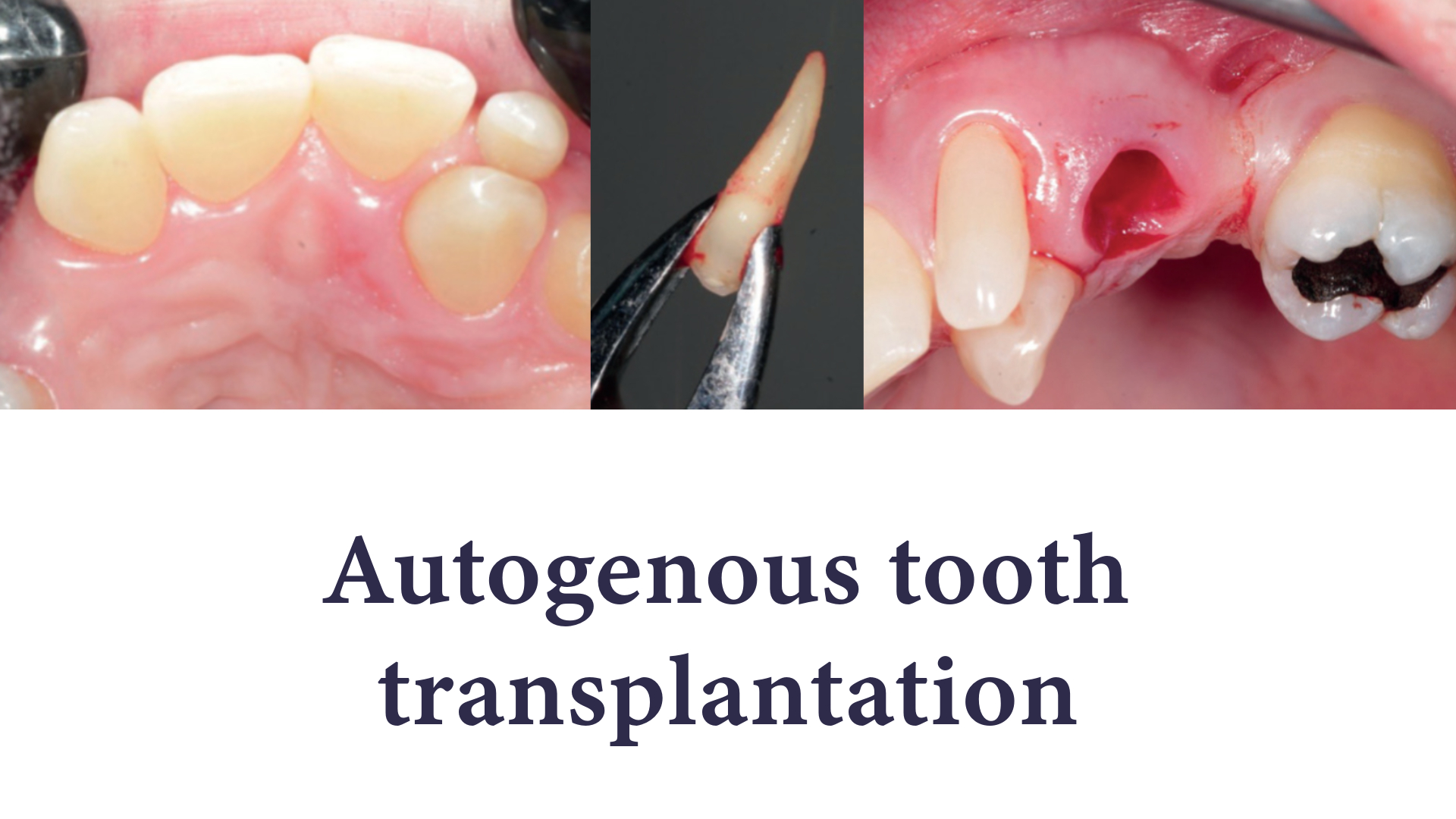
A less well-known but interesting alternative is autogenous tooth transplantation, i.e. the transplantation of a tooth from the patient's own mouth into another cavity. In this procedure, an impacted tooth (e.g. an impacted wisdom tooth or an extra molar) is removed and transplanted into the area where the missing tooth is located. If successful, the transplanted tooth can live and function in that area with its own root.
Transplantation is not a new idea; tooth transplants have been attempted since ancient times. However, modern autogenous transplantation has been defined and developed since the 1950s. Today, success rates have increased considerably with sterile conditions, appropriate techniques and improved follow-up.
